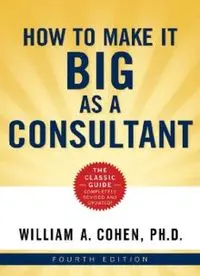Table Of ContentHow to Make It BIG
as a
Consultant
FO U R T H E D I T I O N
This page intentionally left blank
How to Make It BIG
as a
Consultant
FO U R T H E D I T I O N
WILLIAM A. COHEN, PH.D.
American Management Association
New York • Atlanta • Brussels • Chicago • Mexico City • San Francisco
Shanghai • Tokyo • Toronto • Washington, D. C.
Special discounts on bulk quantities of AMACOM books are
available to corporations, professional associations, and other
organizations. For details, contact Special Sales Department,
AMACOM, a division of American Management Association,
1601 Broadway, New York, NY 10019.
Tel.: 212-903-8316. Fax: 212-903-8083.
E-Mail:
This edition is dedicated to
Peter F. Drucker
1909–2005
The Father of Modern Management
and
The World’s Foremost Management Consultant
This page intentionally left blank
CONTENTS
Preface: The World’s Foremost Consultant and His Impact
on This Book xiii
Drucker’s Consulting—How Consultants Get Started—My Initial
Ignorance about Consulting—An Academic Course in Consulting—
The Information in This Book
1 The Business of Consulting 1
What Is Consulting?—How Big Is the Consulting Industry?—Types
of Consulting Firms—Why Does Anyone Need a Consultant?—
Signals Indicating the Need for a Consultant—How Do Potential
Clients Analyze Consultants for Hire?—What Makes an Outstanding
Consultant?—How Much Money Can You Make as a Consultant?—
How Do People Become Consultants?—Summing Up
2 How to Get Clients: Direct Marketing Methods 19
Direct Methods of Marketing—Direct Mail—Cold Calls—Direct
Response Space Advertising—Directory Listings—Yellow Pages
Listings—Approaching Former Employers—Brochures—Designing
Your Brochure—Summing Up
3 How to Get Clients: Indirect Marketing Methods 38
The Basic Indirect Methods—Speaking before Groups—Sending
out Newsletters—Joining Professional Associations—Joining Social
vii
viii CONTENTS
Organizations—Writing Articles—Writing a Book—Writing Letters
to the Editor—Teaching a Course—Giving Seminars—Distributing
Publicity Releases—Exchanging Information with Noncompeting
Consultants—Summing Up
4 Marketing Consultant Services to the Public Sector 55
The Government Requires All Sorts of Consulting Services—
Consulting for the Government—How Do You Get on the
Government Bandwagon?—Federal and State Bidding Portals—
Small Business Administration—The Buying Process—The
Importance of Preproposal Marketing—The Marketing Sequence for
Government Consulting—Locating Potential Clients—Screening—
Visiting and Making the Initial Presentation—Maintaining Contact
and Gathering Intelligence—Preparing the Proposal—Negotiating
the Contract—Summing Up
5 Making the Initial Interview a Success 65
Looking and Acting Like a Professional—How to Build Empathy
with Your Potential Client—Seven Essential Questions—Taking
Notes—Holding off on Giving Advice—Interpreting Body
Language—Making Use of Listening Techniques—Identifying
Emotions from Facial Expressions—What to Do When the
Interview Is Over—The Company Audit—Identification of
Facial Expressions in Figure 5-1—Summing Up
6 How to Write a Proposal 76
Why a Written Proposal Is Necessary—How to Write a Good
Proposal—The Structure of a Letter Proposal—Opening—
Background—Objectives—Study Methods—Potential Problems—
Data Flow Charts and Product Development Schedules—The
Finished Product—Cost and Payment Information—Converting
a Proposal Into a Contract—Summing Up
7 Pricing Your Services 86
Price Strategies and Some Other Considerations—Three Price
Strategies—Other Considerations—Investigate the Marketplace—
CONTENTS ix
Methods of Billing—Daily or Hourly Billing—Working on
Retainer—Performance Billing—Fixed-Price Billing—Disclosing
the Fee—Summing Up
8 What You Must Know About Consulting Contracts 98
Why a Contract is Necessary—Developing Your Own Contract—
If Your Client Has a Standard Contract—Methods of Incurring a
Contractual Obligation—Formal Contracts—Letter Contracts—
Order Agreements—Purchase Orders—Verbal Contracts—Types of
Contracts—The Fixed-Price Contract—The Cost Contract—The
Performance Contract—The Incentive Contract—Elements of a
Contract—A Sample Contract—Summing Up
9 Planning and Scheduling the Consulting Project 109
The Project Development Schedule—Developing a PERT Chart—
Events and Activities—Earliest Expected Date—Latest Allowable
Date—Slack—The Usefulness of PERT—Summing Up
10 Negotiating with Your Client 119
Six Steps in Contract Negotiation, as Seen by Uncle Sam—
Appreciating the Goals and Objectives of the Counterparty—
Preparation:The Key to All Contract Negotiations—Be Wary of
Telephone Negotiations—The Negotiation Plan—Negotiation
Gamesmanship—Making the Other Party Appear Unreasonable—
Placing the Other Party on the Defensive—Blaming a Third Party—
The Good-guy, Bad-guy Technique—Giving up on Straw Issues—
The Walkout—The Recess—The Time Squeeze—More Negotiation
Tactics—Some General Negotiating Hints—Summing Up
11 How to Easily Solve Your Client’s Problems 134
Peter Drucker’s Method of Solving Problems with His Ignorance—
Defining the Central Problem—Listing Relevant Factors—
Listing Alternative Courses of Action—Discussing and
Analyzing the Alternatives—Listing Your Conclusions—Making
Recommendations—The Charles Benson Problem:A Case Study—
The Charles Benson Problem—Solution to the Charles Benson

